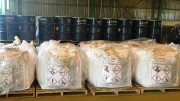A little more than a decade after Bre-X Minerals’ Busang sample salting fiasco, the junior mining industry was hit with another serious case of alleged assay manipulation with news that Southwestern Resources has retracted all previous assay results for its flagship Boka gold project, in southern China’s Yunnan province.
The fallout for Southwestern was predictably ugly — its stock plummeted to a low of $1.25 per share from more than $6.00 as investors pondered the implications of the news. Interestingly, with a reported cash position of $47.8 million, the company is sitting with more than a buck per share in cash, in addition to a portfolio of other projects in Peru and China. Southwestern also boasts about half the equity of affiliate company Zincore Metals and a significant interest in Superior Diamonds.
But even though its worth in cash, investments and other projects might be greater, it’s clear that many Southwestern shareholders owned shares not for those assets, but for Boka.
At issue are deficiencies in control procedures at Boka — discovered and brought forward by Southwestern — that the company believes led to erroneous assay results being published. Additionally, the integrity of some of Southwestern’s drill core has been called into question, leading to the sacking of Boka’s Yunnan-based general manager.
Obviously, these are the some of the issues that National Instrument 43-101 was specifically designed and applied to address. And at Boka, it looks as if it did address them. So the question remains: Who was responsible for the “bad numbers” and can the process be modified to prevent this from happening again?
At this point, it looks like discrepancies exist between the results sent from the assay lab and those that appeared in the company’s news releases. Specifically, results tabled in a mid-February news release indicating an impressive drill intercept of 30.4 metres grading 15 grams gold per tonne are not congruent with the results from the lab.
Responsibility for that falls on John Paterson, Southwestern’s qualified person at the time of the release (he has since been relieved of his duties as CEO and president). Paterson, a professional geologist and founding principal of Southwestern, has so far declined to co-operate with an ongoing review of Boka.
The extent of the inconsistencies is not yet known; the company is now poring over previous assay certificates and comparing those numbers with the corresponding numbers in past releases. The uncertainty more than likely means an updated independent resource estimate prepared by SRK Engineering in 2006 will have to be redone.
The company is right to be auditing its procedures for quality assurance and control at Boka. Cognizant of the implications this type of event could have for Southwestern and for junior mining in general, we think credit goes to Southwestern for being forthright to date in reporting its findings.
However, in addition to now having to build back its credibility after the stigma of “bad numbers,” the company has also been saddled with a $220-million class action lawsuit launched by a group of shareholders. Of note, those shareholders enlisted the legal expertise of law firm Sutts Strosberg, the kings of Canadian class actions and the firm that continues to wage a class action suit against Bre-X.
What should the industry do? Perhaps one measure could be to require that assay certificates be filed as appendices to the corresponding news releases on SEDAR. If this issue is to be addressed in future revisions of National Instrument 43-101, it should be digested and reviewed by the regulators sooner rather than later.
While the full implications of Southwestern Resources’ Boka assay issues are not yet known, the project’s scale is thankfully much smaller than Bre-X purported Busang to be before that facade came tumbling down. There also seems to be little doubt that there is actually significant gold mineralization at Boka. But Southwestern will now have to work a whole lot harder to prove to shareholders that Boka is a worthwhile investment.



Be the first to comment on "Editorial: No, Boka’s not another Busang"